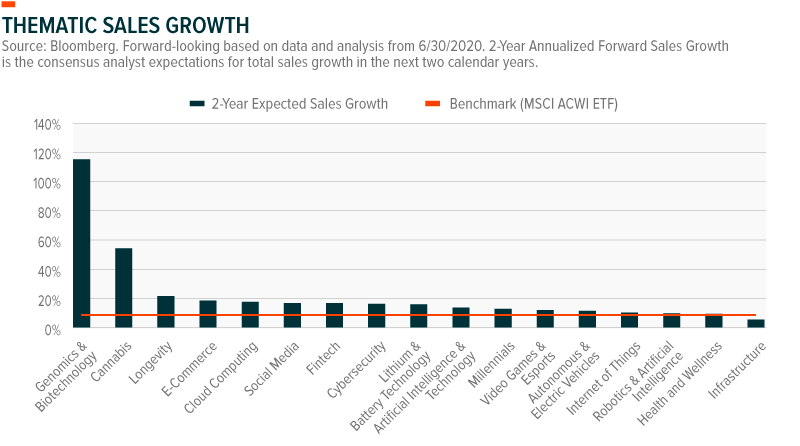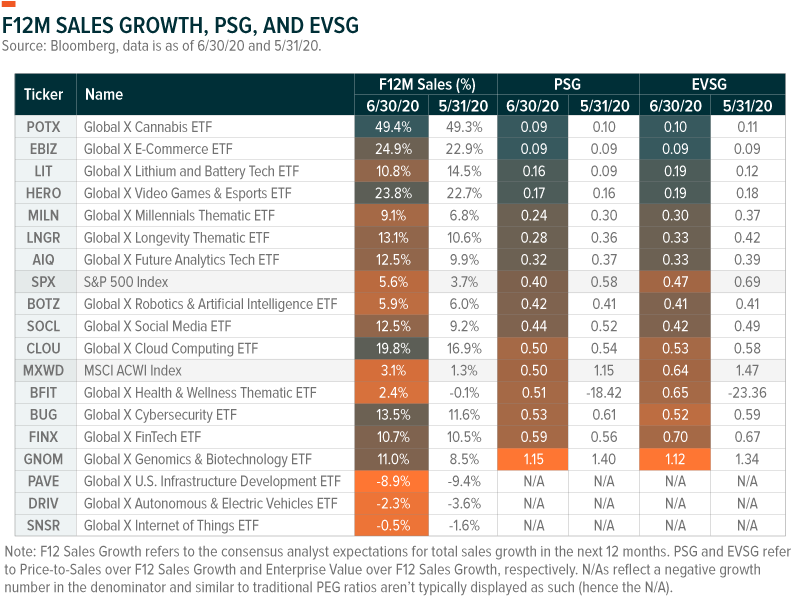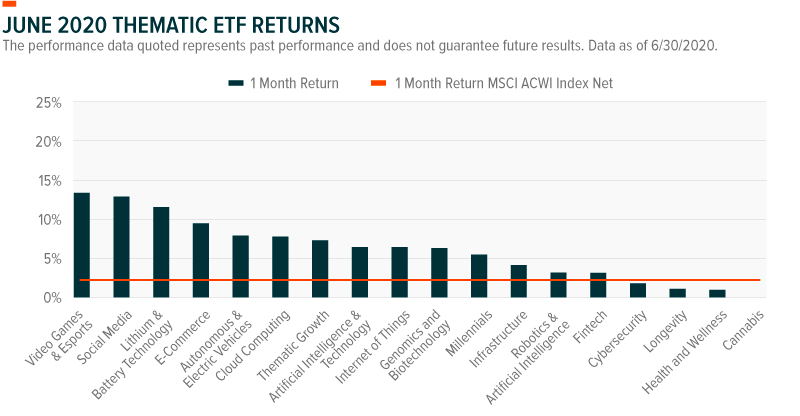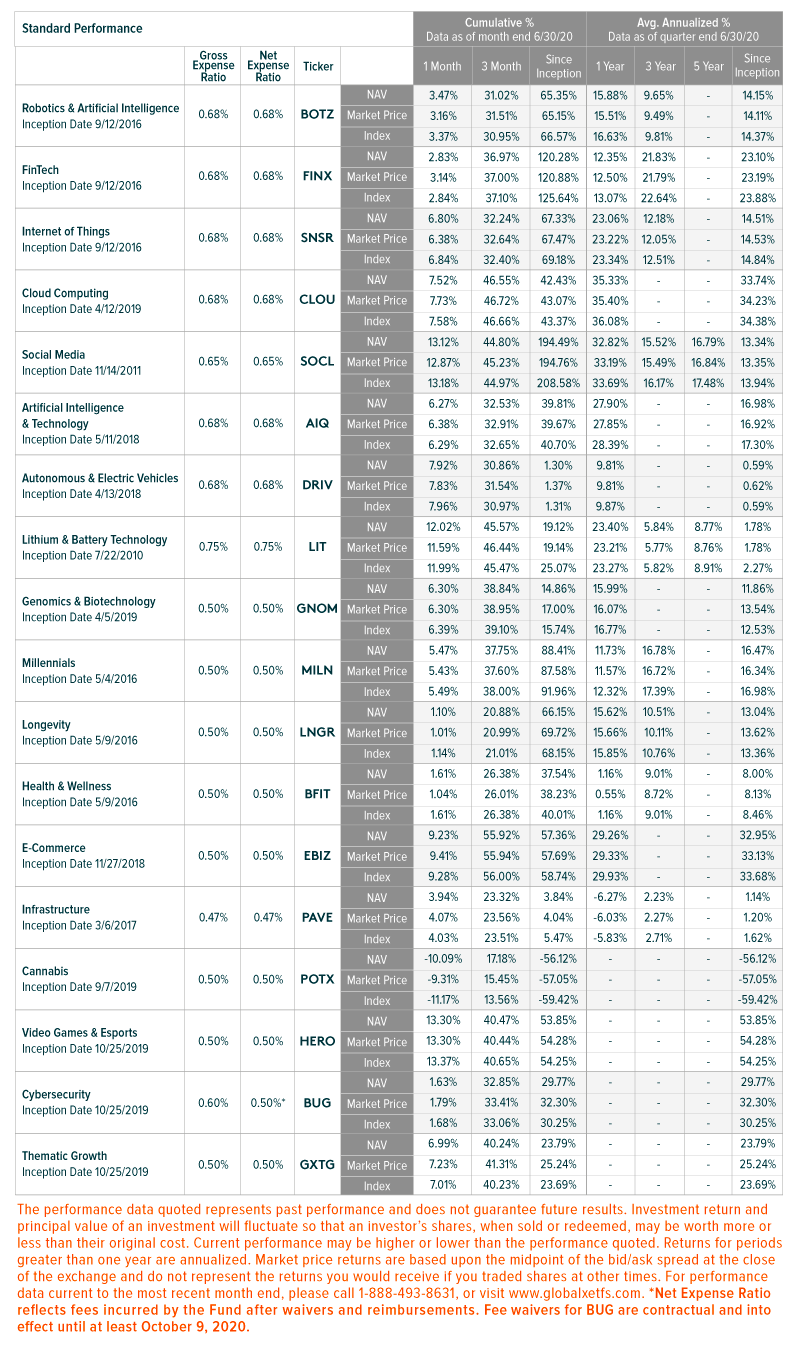
Health & Wellness
Consumers on a Health Kick
Americans are pursuing healthier eating habits during COVID-19. According to the International Food Information Council’s (IFIC) 2020 Food and Health Survey, 60% of Americans reported cooking at home more, and more than 20% reported eating healthier than usual.1 Forty-three percent of respondents indicated that they would adhere to stricter dietary guidelines in the coming year, up from 38% going into 2019. Many respondents also communicated a willingness to embrace meat and dairy alternatives.2 Consumers show more concern that their environment is healthy as well. The share of consumers focusing on environmental sustainability reached 39% entering 2020, up almost 10% year over year (YoY). And over 40% of shoppers noted that they prioritize environmentally-conscious farming practices in their purchasing decisions.

E-commerce
Pandemic Shopping Goes Online
Recent sales numbers illustrate how e-commerce is made for the stay-at-home economy. May sales were up 92.7% YoY in the U.S. For May and June, consumers spent more than $53 billion online, totaling 22% of all U.S. retail sales for that period.3 Notably, U.S., e-commerce home improvement sales increased 149% YoY, leading footwear (64%) and apparel (41%). Looking abroad, U.K., online grocery sales increased 76% YoY, demonstrating how COVID-19 stoked penetration in historically weak areas.4 The e-commerce boom has some retailers like Zara closing physical stores. In tech, giants Google and Amazon are responding to recent sales trends with digital advertisement enhancements, services support, and expanded digital payment services.5

Social Media
Show Them What They Want
Anything that enhances the user experience remains front and center in social media circles. Google launched Keen, a new application that tracks its users’ interests and hobbies to suggest relevant new content.6 LinkedIn designed its “10 Free Learning Paths” for those facing COVID-induced unemployment. The program, which includes partnerships with GitHub and Microsoft Learn, seeks to help workers develop and refine skillsets.7 LinkedIn also implemented a “support” reaction and an “open to work” feature on its platform.8 Increased video viewership prompted Facebook to increase creator monetization opportunities through live ads, video ads, and new ad experiences. The move is a response to a surge in Facebook’s Portal sales and the rapid rise of Zoom.9 Support for creators also includes Instagram’s new e-commerce platform, which allows customers to purchase directly from creators through the app.10

Video Games & Esports
Sales Notch New High Scores
The COVID-19 crisis has console and video game sales soaring. In the U.S., consumers spent $977 million on video games, accessories and consoles in May, a striking 52% YoY increase.11 Share prices for industry leaders Activision Blizzard, Nintendo, and Take-Two Interactive are up approximately 25% since early March.12 The upcoming PlayStation 5 console and Xbox Series X launches are expected to continue the industry’s momentum. Mobile gaming continues to roll as well. The industry is expected to hit a record $100 billion in revenue by the end of 2020, according to analytics firms App Annie and IDC. For comparison, $100 billion would be triple the sum of console revenues from the Nintendo Switch, Xbox One and PlayStation 4.13

Cloud Computing
Cloud Computing in Orbit
A surge in U.S. military and civilian agency interest in space has triggered an increase in space-related cloud computing projects. Amazon Web Services plans to launch a dedicated segment for Aerospace and Satellite Solutions.14 And Microsoft entered a 3-year, $8M contract with NASA, securing Azure as the organization’s main provider for cloud services.15 Back on Earth, with remote work budgets increasing 4% YoY in 2020, firms now consider cloud computing the third most critical technology behind digital transformation and cybersecurity when it comes to spending.16,17 As remote work budgets are increasing, 49% of firms are purchasing or expect to purchase cloud technology that supports their remote work infrastructure.18

U.S. Infrastructure
Always a Catch: How to Pay for It?
The Trump administration proposed a $1.5 trillion infrastructure bill to bolster the American economy.19 The bill lays out plans to spend $300 billion to build and fix roads and bridges; $100 billion for low-income schools; and $100 billion for transit and telecommunication in rural regions.20 The news sparked U.S infrastructure stocks to jump, with U.S concrete shares to marking a 22.5% increase week over week, and also ignited hopes of bringing manufacturing back to the United States.21 Though it’s possible this particular bill could materialize in the not-too-distant future, how the administration plans to finance such an ambitious project remains to be seen. Adding to the uncertainty is that financing for the administration’s $2 trillion infrastructure plan from April 2019 has yet to be hashed out.
THE NUMBERS
The following tables and charts examine returns and sales growth expectations by theme, based on their corresponding ETFs.





INTRO TO THEMATIC INVESTING COURSE – ELIGIBLE FOR CE CREDIT
Global X has developed an interactive, self-guided Intro to Thematic Investing course, that is designed to share the latest ideas and best practices for incorporating thematic investing into a portfolio.
This program has been accepted for 1.0 hour of CE credit towards the CFP®, CIMA®, CIMC®, CPWA® or RMA certifications. To receive credit, course takers must submit accurate and complete information on the requested forms, complete the entire course, and receive a 70% or higher on the Intro to Thematic Investing Quiz.
For Canadian course takers: This program has been reviewed by FP Canada and qualifies for 1 FP Canada-Approved CE Credit, in the category of Product Knowledge, towards the CFP® certification or QAFP™ certification. To receive credit, course takers must submit accurate and complete information (including Job Title) on the requested forms, complete the entire course, and receive a 70% or higher on the Intro to Thematic Investing Quiz.
Questions on receiving CE credit may be sent to: Education@globalxetfs.com
KEEP UP WITH THE LATEST RESEARCH FROM GLOBAL X
To learn more about the disruptive themes changing our world, read the latest research from Global X, including:
- Genomics: How a Cutting-Edge Field is Fighting COVID-19
- Can Lithium Keep Up With the EV Boom?
- Webinar Replay: Thematic Investing and the Stay-at-Home Economy
- Four Companies Leading the Rise of Video Games & Esports
- Thematic Disruption Accelerates & Expands Amid COVID-19 Pandemic
ETF HOLDINGS AND PERFORMANCE:
To see individual ETF holdings and current performance across the Global X Thematic Growth Suite, click the below links:
- Disruptive Technology: Global X Future Analytics Tech ETF (AIQ), Global X Robotics & Artificial Intelligence ETF (BOTZ), Global X Cybersecurity ETF (BUG), Global X Cloud Computing ETF (CLOU), Global X Autonomous & Electric Vehicles ETF (DRIV), Global X FinTech ETF (FINX), Global X Video Games & Esports ETF (HERO), Global X Lithium and Battery Tech ETF (LIT), Global X Internet of Things ETF (SNSR), Global X Social Media ETF (SOCL)
- People and Demographics: Global X Cannabis ETF (POTX), Global X Millennials Thematic ETF (MILN), Global X Health & Wellness Thematic ETF (BFIT), Global X E-Commerce ETF (EBIZ), Global X Genomics & Biotechnology ETF (GNOM), Global X Longevity Thematic ETF (LNGR)
- Infrastructure Development: Global X U.S. Infrastructure Development ETF (PAVE)
- Multi-Theme: Global X Thematic Growth ETF (GXTG)
 Pedro Palandrani
Pedro Palandrani